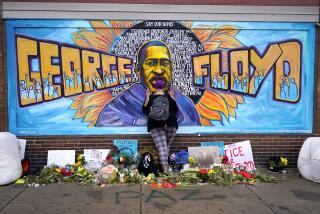Despite Lapses, We Have Made Moral Progress Against Prejudice
- Share via
The bloodiest century in human history is about to end. It was made especially bloody by the immense genocide we now know as the Holocaust. Yet genocides continue. And, despite their consequences, the same kinds of racial theories that were used to justify the Holocaust continue to be propagated by hate groups--as demonstrated recently by the shooting and killing rampage aimed at racial and religious minorities in Illinois and Indiana. Have we learned no lessons from the bloody past? Is moral progress, after all, not possible?
In America, when we hear about genocides and crimes against humanity that occur elsewhere, we shudder but think of the ethnic hatreds that underlie them. For us, though, the hate crimes that occur here, while incomparably less devastating, seem especially vexing, in part because many of them are inspired by the idea that certain groups in the human family are inferior and not worthy of life.
Post-Holocaust society, especially in America, wasn’t supposed to be this way.
Religious and political figures have preached the importance of accepting the other--the other ethnic group, the other racial group, the other gender group, the other sexually oriented group.
And other elements in American life have broadcast, in especially powerful ways, the same message. Films, television programs and media features on the Holocaust have proliferated, spreading widely an awareness of the dangers of targeting certain groups as inferior.
Museums on the Holocaust and on tolerance emphasizing the same message have been visited by a huge number of Americans; during the years I directed the United States Holocaust Memorial Museum in Washington, I was astonished every day by the crowds that gathered to see it--more than 2 million a year, half of them children, and more than 80% of them non-Jews.
And school systems in numerous states have mandated Holocaust education programs, convinced that teaching about that event increases the sensitivity of young Americans to the dangers of prejudice.
Yet none of these preachings, films, television series, museums or educational programs seem to have deterred Benjamin Nathaniel Smith, whose shooting rampage over the Fourth of July weekend against blacks, Jews and Asians left two dead and 12 wounded. In fact, in an article he published in a white supremacist newsletter, he complained that the eighth-grade class on the Holocaust to which he was exposed in an affluent Chicago suburb had been designed “to instill a strong and lasting sense of white guilt.”
By using the word “white,” Smith wasn’t being quite literal. The victims of the Holocaust were, after all, white themselves. His resentment was against required educational programs that are critical of prejudice, whether against nonwhites or others; for him, not only were nonwhite minorities inferior creatures but so, too, were the most ancient targets of prejudice in the Western world: Jews.
Does this mean that such programs--as well as religious teachings, museums, films and television series--are futile? Can we, in the end, really do nothing more effective than echo the hopeful but unrealistic sentiment issued by President Clinton soon after the killings that “we should rid our hearts of hatred immediately”?
I don’t think that the killings by Smith--or the racist teachings of his mentor, Matthew F. Hale, the leader of the World Church of the Creator--justify such conclusions. Even with the best educational programs, the finest museums and the must effective films, there will always be killers and the haters whose ideas motivate them. It’s not likely that our hearts, individually or communally, can ever be rid of all hatred, whether immediately or over generations. This seems true at home no less than it’s true abroad. The reality of ethnic, racial and religious hatred spans both history and continents.
Yet such programs do something very important: They change the general culture. Because of them, racial and ethnic hatreds are regarded as less acceptable and more deviant. We have to remember, by remembering the general culture of Nazi Germany, how normal and even desirable racist and anti-Semitic theories and the actions that flowed from them became. When hate crimes occur now, we take notice. And when individuals have such attitudes, they are more likely to suppress them, or not act on them, if the general culture disapproves of them.
This doesn’t mean that there won’t be more haters like Benjamin Nathaniel Smith or more hate groups like the World Church of the Creator. But it does mean that, in this society, in part because of its teachings, those haters will be shunned; that their numbers will be limited; and that we’ll continue to be shocked and angered each time the hate, and the killing, break through.
That doesn’t prevent the disease. But it limits its occurrence and strengthens the society it seeks to destroy. That’s not a cure, but it’s a lot.
More to Read
Sign up for Essential California
The most important California stories and recommendations in your inbox every morning.
You may occasionally receive promotional content from the Los Angeles Times.









